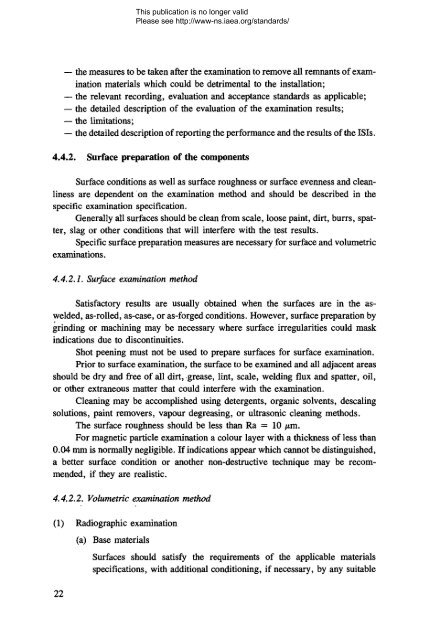In-Service Inspection of Nuclear Power Plants - gnssn - International ...
In-Service Inspection of Nuclear Power Plants - gnssn - International ...
In-Service Inspection of Nuclear Power Plants - gnssn - International ...
Create successful ePaper yourself
Turn your PDF publications into a flip-book with our unique Google optimized e-Paper software.
This publication is no longer valid<br />
Please see http://www-ns.iaea.org/standards/<br />
— the measures to be taken after the examination to remove all remnants <strong>of</strong> examination<br />
materials which could be detrimental to the installation;<br />
— the relevant recording, evaluation and acceptance standards as applicable;<br />
— the detailed description <strong>of</strong> the evaluation <strong>of</strong> the examination results;<br />
— the limitations;<br />
— the detailed description <strong>of</strong> reporting the performance and the results <strong>of</strong> the ISIs.<br />
4.4.2. Surface preparation <strong>of</strong> the components<br />
Surface conditions as well as surface roughness or surface evenness and cleanliness<br />
are dependent on the examination method and should be described in the<br />
specific examination specification.<br />
Generally all surfaces should be clean from scale, loose paint, dirt, burrs, spatter,<br />
slag or other conditions that will interfere with the test results.<br />
Specific surface preparation measures are necessary for surface and volumetric<br />
examinations.<br />
4.4.2.1. Surface examination method<br />
Satisfactory results are usually obtained when the surfaces are in the aswelded,<br />
as-rolled, as-case, or as-forged conditions. However, surface preparation by<br />
grinding or machining may be necessary where surface irregularities could mask<br />
indications due to discontinuities.<br />
Shot peening must not be used to prepare surfaces for surface examination.<br />
Prior to surface examination, the surface to be examined and all adjacent areas<br />
should be dry and free <strong>of</strong> all dirt, grease, lint, scale, welding flux and spatter, oil,<br />
or other extraneous matter that could interfere with the examination.<br />
Cleaning may be accomplished using detergents, organic solvents, descaling<br />
solutions, paint removers, vapour degreasing, or ultrasonic cleaning methods.<br />
The surface roughness should be less than Ra = 10 fim.<br />
For magnetic particle examination a colour layer with a thickness <strong>of</strong> less than<br />
0.04 mm is normally negligible. If indications appear which cannot be distinguished,<br />
a better surface condition or another non-destructive technique may be recommended,<br />
if they are realistic.<br />
4.4.2.2. Volumetric examination method<br />
(1) Radiographic examination<br />
22<br />
(a) Base materials<br />
Surfaces should satisfy the requirements <strong>of</strong> the applicable materials<br />
specifications, with additional conditioning, if necessary, by any suitable

















